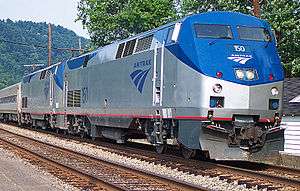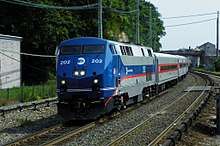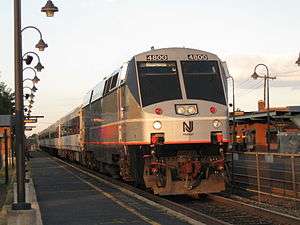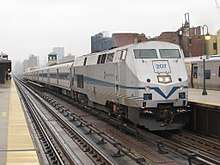GE Genesis
General Electric Genesis (officially trademarked GENESIS[5]) is a series of passenger diesel locomotives produced by GE Transportation, then a subsidiary of General Electric. Between 1992 and 2001, a total of 321 units were built for Amtrak, Metro-North, and Via Rail.
| GE Genesis | |||||||||||||||||||||||||||||||||||||||||||||||||||||||||||||||||||||
|---|---|---|---|---|---|---|---|---|---|---|---|---|---|---|---|---|---|---|---|---|---|---|---|---|---|---|---|---|---|---|---|---|---|---|---|---|---|---|---|---|---|---|---|---|---|---|---|---|---|---|---|---|---|---|---|---|---|---|---|---|---|---|---|---|---|---|---|---|---|
 GE P42DC #150 on the Cardinal in 2006 | |||||||||||||||||||||||||||||||||||||||||||||||||||||||||||||||||||||
| |||||||||||||||||||||||||||||||||||||||||||||||||||||||||||||||||||||
| |||||||||||||||||||||||||||||||||||||||||||||||||||||||||||||||||||||
| |||||||||||||||||||||||||||||||||||||||||||||||||||||||||||||||||||||
| |||||||||||||||||||||||||||||||||||||||||||||||||||||||||||||||||||||
The Genesis series of locomotives was designed by General Electric in response to a specification published by Amtrak and ultimately selected over a competing design presented by Electro-Motive Diesel (EMD). The Genesis series are the lowest North American diesel-electric locomotives. This height restriction allows the locomotive to travel easily through low-profile tunnels in the Northeast Corridor. The Genesis series is lower than even the previous-generation F40PH by 14 inches (356 mm).
Technical design

The GE Genesis series is unique among recently manufactured North American passenger locomotives in that it uses a single, monocoque carbody design styled by industrial designer Cesar Vergara,[6] thus making it lighter, more aerodynamic,[7] and more fuel efficient than its predecessors (F40PH, F59PH, P30CH, P32-BWH). However, this makes it more costly and time-consuming to maintain and repair. In 2004, Amtrak started installing bolt-on nose cones on its units for easy replacement in the event of a grade crossing collision with a vehicle. As an example of the improvements over the predecessor locomotives, the Genesis is 22% more fuel-efficient than the F40PH while producing 25% more horsepower.[8] In addition, all Genesis locomotives have four-stroke engines instead of the two-stroke engines previously used in EMD counterparts.
The Genesis unit is a fully computerized locomotive which automatically controls all on-board functions, thus producing high reliability while keeping the maintenance requirements low. For example, its computers can automatically reduce the power plant's output in the event that the locomotive is overheating, or suffering from low oil pressure, low water pressure, or reduced airflow into the intakes, thus making it still operable.[8]
All Genesis engines can provide head-end power (HEP) to the train drawn from an alternator or inverter powered by the main engine at a maximum rating of 800 kilowatts (1,100 hp), making each unit capable of providing HEP for up to 16 Superliner railcars. The P40DC and P42DC power plants can supply 60-hertz head-end power either from the HEP alternator with the engine speed-locked to 900 rpm (normal mode) or from the traction alternator with the engine speed-locked to 720 rpm (standby mode). In the latter case, traction power is unavailable. The P32AC-DM powerplant does not have to be locked at a certain rpm because it utilizes an HEP inverter, which allows the prime mover to run at 1047 rpm when providing both traction power and HEP, and to idle at 620 rpm (or notch three) while still providing HEP for lighting and air-conditioning when not providing traction power.
The trucks of Genesis locomotives were made by Krupp Verkehrstechnik, which has since been absorbed by Siemens Mobility; the trucks on the newest Genesis locomotives carry the Siemens name.
Models
Three models of Genesis were built by General Electric, the P40DC, P42DC, and P32AC-DM.
P40DC

The P40DC (GENESIS Series I)[9] or Dash 8-40BP (originally known as the AMD-103 or Amtrak Monocoque Diesel - 103MPH) is the first model in the Genesis series, built in 1993.[10] The locomotive operates in a diesel-electric configuration that uses DC to power the traction motors, producing 4,000 horsepower (2,980 kW) output at 1047 rpm. Power output to the traction motors is 3,550 hp (2,650 kW) when running in HEP mode (900 rpm) with a 0 kW HEP load. Traction horsepower in HEP mode decreases to a bare minimum of 2,525 horsepower (1,880 kW) when providing the maximum 800 kW (1,100 hp) HEP load to the train. The P40DC is geared for a maximum speed of 103 miles per hour (166 km/h). The P40DC was succeeded in 1996 by the P42DC.
A feature unique to the P40DC and P32AC-DM is a hostler stand at the rear of the locomotive providing increased visibility and reversing capabilities to the engineer while conducting reverse operations. When a unit is in operation from this stand it is limited to 10 mph (16 km/h) and a dead man's switch protects against movement without an operator being present. Two unique features to the original P40DC are the two strobes above the cab and an emergency flasher between the strobes. When they were overhauled, those features were removed.[8]
Both the P40DC and P42DC allowed Amtrak to operate heavy long-distance trains with fewer locomotives compared to the older EMD F40PH locomotives; two P40DCs could do the same work as three F40PHs. Additional deliveries of the P42DC ended up replacing the P40DCs. Three units were wrecked (819 in the 1993 Big Bayou Canot train wreck and 807 and 829 in the 1999 Bourbonnais, Illinois, train crash) and scrapped. Eight were leased and later sold to the Connecticut DOT for Shore Line East in 2005, and four were rebuilt and sold to New Jersey Transit in 2007; these units were sold again to the Connecticut DOT in 2015. The remaining 29 units were placed out-of-service for many years. 15 of these units have been rebuilt using 2009 ARRA stimulus funds and returned to service, now in the Phase V livery, except for 822, which is painted in Phase III Heritage livery for Amtrak's 40th Anniversary.[11] The units that were not rebuilt remain in storage or have since been disposed.
In January 2018, ConnDOT awarded a contract to Amtrak to overhaul all 12 of their P40DC locomotives at the Beech Grove Shops.[12]
Upgraded and "Stimulus" P40DCs
.jpg)
By 2007, New Jersey Transit had upgraded their P40DC units with updated prime movers to match the 4,250 horsepower (3,170 kW) of the successor P42DC.[13] This was done by readjusting the position of the lay shafts within the prime mover.
Amtrak has returned 15 of their P40DC units to service as part of a project funded through the American Recovery and Reinvestment Act of 2009.[14] The first of the units were returned to service in March 2010 after being overhauled at the Beech Grove Shops. They were upgraded like NJT's units had been a few years before to have 4,250 hp (3,170 kW) and match the P42DC's maximum speed of 110 mph (177 km/h). They also received updated cab signaling systems. The upgraded locomotives still have mechanical air brakes, which makes them most suitable for trains that only require a single locomotive. This differs from the electronic air brakes on the P42DC and P32AC-DM.[15] They also feature a builder's plate indicating that they were rebuilt under the auspices of the TIGER stimulus program.
P42DC
.jpg)
The P42DC (GENESIS Series I)[16] is the successor model to the P40DC. It has an engine output of 4,250 horsepower (3,170 kW) at 1047 rpm, or 3,550 horsepower (2,650 kW) when running in HEP mode (900 rpm) with a 0 kW HEP load. Traction horsepower in HEP mode decreases to a bare minimum of 2,525 horsepower (1,880 kW) when providing the full 800 kW HEP load to the train.
The P42DC has a maximum speed of 110 mph (177 km/h). Tractive effort is rated at 280.25 kN (63,000 lbf) of starting effort and 169 kN (38,000 lbf) of continuous effort at 38 mph (61.2 km/h) given wheel horsepower of 3,850 horsepower (2,870 kW).[3]
P42DCs are used primarily on most of Amtrak's long-haul and higher-speed rail service outside the Northeast and lower Empire Corridors. They will be replaced on long-distance service by 75 Siemens ALC-42 Charger locomotives between 2021 and 2024, but will remain in service on shorter routes.[17]
Via Rail Canada has utilized P42DC locomotives since 2001, when they replaced the LRC locomotives in 2001. They are currently on services with speeds up to 100 mph (161 km/h), mainly on the Quebec City-Windsor rail corridor.[18]
P32AC-DM

The P32AC-DM (GENESIS Series II, short for "Passenger, 3200hp, Alternating Current, Dual Mode")[19] was developed for both Amtrak and Metro-North. They can operate on power generated either by the on-board diesel prime mover or power collected from a third rail electrification system at 750 volts direct current. The P32AC-DM is rated at 3,200 horsepower (2,390 kW), 2,900 horsepower (2,160 kW) when supplying HEP, and is geared for a maximum speed of 110 mph (177 km/h). Tractive effort is rated at 275.8 kN (62,000 lbf) of starting effort from 0 mph (0.00 km/h) to 14 mph (22.5 km/h) and 113.43 kN (25,500 lbf) of continuous effort at 40 mph (64.4 km/h) given wheel horsepower of 2,700 horsepower (2,010 kW).[4]
The P32AC-DM is unique as it is equipped with GE's GEB15 AC (alternating current) traction motors, rather than DC (direct current) motors as used in the other subtypes.[20] It is also only one of two modern American electro-diesel locomotives with third-rail capability, along with the EMD DM30AC operated by the Long Island Rail Road. NJ Transit and Exo's Bombardier ALP-45DP electro-diesel locomotive can operate from overhead catenary electrification.
The model is only used on services operating north from New York City, where diesel emissions through its two fully enclosed main terminal stations are prohibited. The type operates on Amtrak's Empire Service, Ethan Allen Express, Lake Shore Limited (New York section), Adirondack, and Maple Leaf services. The P32AC-DMs are sometimes traded out for a P42DC or the other way around on southbound trains at Albany due to the requirement for the P32AC-DM only applying to the section of the route south of Albany, and the higher horsepower rating of the P42DC.
Metro-North's push-pull trains to and from Grand Central Terminal also utilize P32AC-DM units. Some of the units are owned by the Connecticut Department of Transportation and are painted in the New Haven Railroad's 'McGinnis' scheme.
The third-rail shoes are used on the over-running third-rail into Penn Station for Amtrak units and the under-running third-rail into Grand Central Terminal for Metro-North.
All P32AC-DM models, unlike the P40DC and P42DC models, lack the door on the rear of the locomotive that would normally lead to the next car, making it impossible to access the locomotive from either a coach or a trailing engine. Another unique feature is that the two lower vents near the back of the locomotive are bigger than that of the P40s and P42s. Additionally, Metro-North's P32AC-DM units feature an emergency exit hatch in the front, due to tight clearances in the Park Avenue tunnel which make evacuating the engine crew via the side doors impossible. Some of Amtrak's P32AC-DM units were retrofitted with these exit hatches during the 2018 reroute from Penn Station to Grand Central.
Original owners
| Railroad | Model | Quantity | Road numbers | Notes |
|---|---|---|---|---|
| Amtrak | P40DC | 44 | 800-843 | 15 units rebuilt to P42 specifications and are the only locomotives that remain in service. All others have been retired and are placed in storage, sold to other operators or scrapped. To be replaced by ALC- 42 Siemens Charger. |
| P42DC | 207 | 1-207 | Various units are out of service due to incidents. | |
| P32AC-DM | 18 | 700-717 | Used on the Empire Corridor between Albany and New York Penn. Over-running 3rd rail shoe for use into Penn Station where diesel engines are forbidden. | |
| Via Rail | P42DC | 21 | 900-920 | Retrofitted with third "High-Intensity Discharge" headlight below front numberboard. Most were wrapped in Canada 150 scheme (except 901, 902, 915 & 917). |
| Metro-North Railroad | P32AC-DM | 30 | 201-231 | Dual mode for operation into Grand Central Terminal. 201–227 are in Metro-North paint scheme, while 228–231 are owned by Connecticut Dept of Transportation and bear "New Haven" paint scheme |
See also
References
| Wikimedia Commons has media related to GE Genesis locomotives. |
- "王涛的Development of the Low-Emission GE-7FDL High-Power Medium-Speed Locomotive Diesel Engine - 百度文库". wenku.baidu.com.
- "Genesis Series 2 - Dual Mode Passenger Locomotive for Amtrak". August 21, 2001. Archived from the original on August 21, 2001.
- Page 14
- Page 29
- "Earlier Locomotive Models". GE Transportation. Archived from the original on September 28, 2010. Retrieved September 27, 2010.
- Gormick, Greg (November 21, 2005). "High style, high tech; Putting style back on track". Toronto Star. p. D01. ProQuest 438900729.
- US 5535680
- Warner, David C (June 1993). "AMD103: Powering Amtrak Into the 21st Century". Passenger Train Journal. Interurban Press. 24, No. 6 (186): 23. ISSN 0160-6913.
- P40DC Builders Plate https://www.flickr.com/photos/davidfullarton/4412331923/
- "Make way for the Genesis Series". Trains. Vol. 53. August 1993.
- "On Track On Line - Stored, Sold and Leased P40s". on-track-on-line.com.
- "Notice of Contract Award" (PDF). Connecticut Department of Transportation. April 25, 2018.
- Donald Albertson (September 13, 2007). "NJT 808". rrpicturearchives.net. Archived from the original on July 16, 2011. Retrieved September 27, 2010.
- http://www.amtrak.com/pdf/ARRA/Amtrak-ARRA_Project-Summary-FY-09.pdf Amtrak ARRAProject List
- Bob Johnston (October 2010). "Beech Grove to the Rescue". Trains. Vol. 70 no. 10. pp. 48–53.
- P42 Builders Plate https://www.flickr.com/photos/76498245@N05/6871547365/in/photostream
- "Amtrak to Improve National Network with New Locomotives" (Press release). Amtrak. December 21, 2018.
- "Locomotives - P42DC | VIA Rail". corpo.viarail.ca.
- P32 Builders Plate https://www.flickr.com/photos/blazer8696/4984725506/
- Brian Solomon (2000). American Diesel Locomotives. MBI Publishing Company. p. Page 160. ISBN 0-7603-0666-4. Retrieved September 25, 2008.